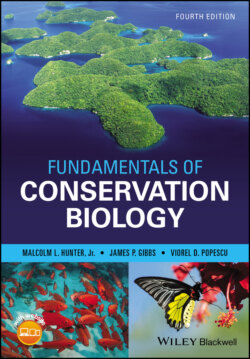Читать книгу Fundamentals of Conservation Biology - Malcolm L. Hunter Jr. - Страница 24
Coda
ОглавлениеThe Española tortoises, once abandoned and quietly relegated to extinction, have returned to their native ground. All 15 surviving tortoises found 60 years ago are still alive in June 2020 and all were retired back to their original home on Española to be with their hundreds of offspring and “grand‐offspring.” They are now essentially taking care of themselves. Humans can step back out of the picture, after being a destructive force and then a healing one, and let the tortoises and their ecosystem resume interacting as they did for thousands of years previously. Conservation has succeeded. It was accomplished by a cadre of dedicated individuals, mostly Ecuadorian park managers and scientists with some foreign support, working with scarce funds. Because of the program’s success, Española tortoises are now being liberated on another island – nearby Santa Fe Island that lost its tortoises 200 years ago – to restore the ecological role of tortoises there and develop an “insurance” colony for Española tortoises. It is an example of the awesome power of humans to control the fate of wild life. It is also an example of how we can be both agents of destruction and benevolent stewards of restoration. This book seeks to explore these issues with you in much greater detail and to provide guidance on achieving positive outcomes for the many creatures around the world that, like the Española tortoises, are still struggling to survive.
1 Primary sources for this section were: Marquez et al. (1991), Milinkovitch et al. (2004), Gibbs et al. (2014), and personal observations.
